seats Alfa Romeo 8C 2007 Owner handbook (in English)
[x] Cancel search | Manufacturer: ALFA ROMEO, Model Year: 2007, Model line: 8C, Model: Alfa Romeo 8C 2007Pages: 223, PDF Size: 14.35 MB
Page 23 of 223
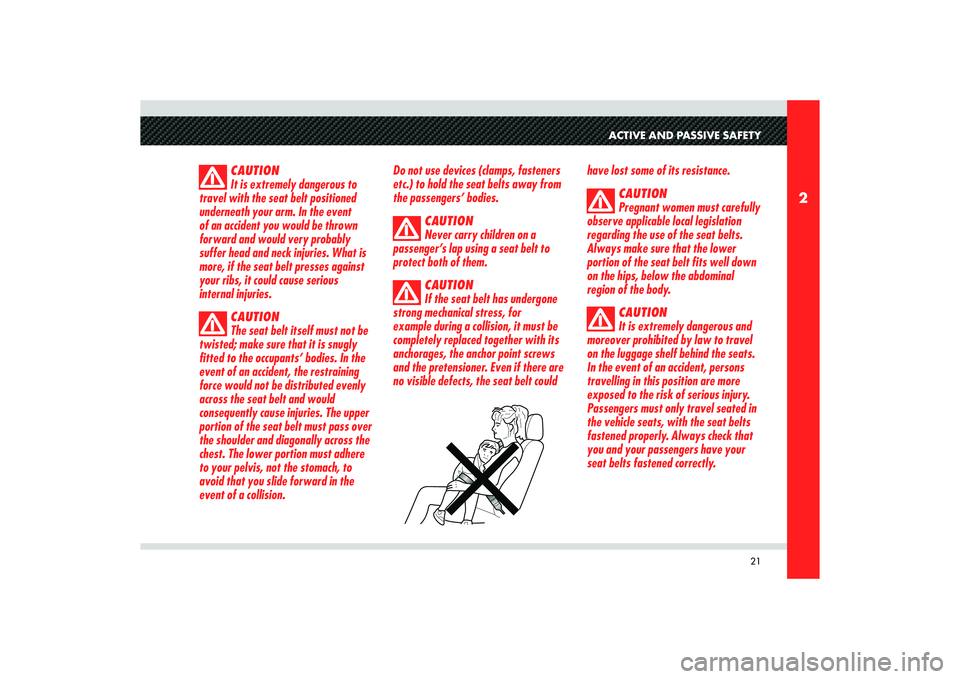
21
2
ACTIVE AND PASSIVE SAFETY
CAUTION
It is extremely dangerous to
travel with the seat belt positioned
underneath your arm. In the event
of an accident you would be thrown
forward and would very probably
suffer head and neck injuries. What is
more, if the seat belt presses against
your ribs, it could cause serious
internal injuries.
CAUTION
The seat belt itself must not be
twisted; make sure that it is snugly
fitted to the occupants’ bodies. In the
event of an accident, the restraining
force would not be distributed evenly
across the seat belt and would
consequently cause injuries. The upper
portion of the seat belt must pass over
the shoulder and diagonally across the
chest. The lower portion must adhere
to your pelvis, not the stomach, to
avoid that you slide forward in the
event of a collision. Do not use devices (clamps, fasteners
etc.) to hold the seat belts away from
the passengers’ bodies.
CAUTION
Never carry children on a
passenger’s lap using a seat belt to
protect both of them.
CAUTION
If the seat belt has undergone
strong mechanical stress, for
example during a collision, it must be
completely replaced together with its
anchorages, the anchor point screws
and the pretensioner. Even if there are
no visible defects, the seat belt could have lost some of its resistance.
CAUTION
Pregnant women must carefully
observe applicable local legislation
regarding the use of the seat belts.
Always make sure that the lower
portion of the seat belt fits well down
on the hips, below the abdominal
region of the body.
CAUTION
It is extremely dangerous and
moreover prohibited by law to travel
on the luggage shelf behind the seats.
In the event of an accident, persons
travelling in this position are more
exposed to the risk of serious injury.
Passengers must only travel seated in
the vehicle seats, with the seat belts
fastened properly. Always check that
you and your passengers have your
seat belts fastened correctly.
Page 24 of 223
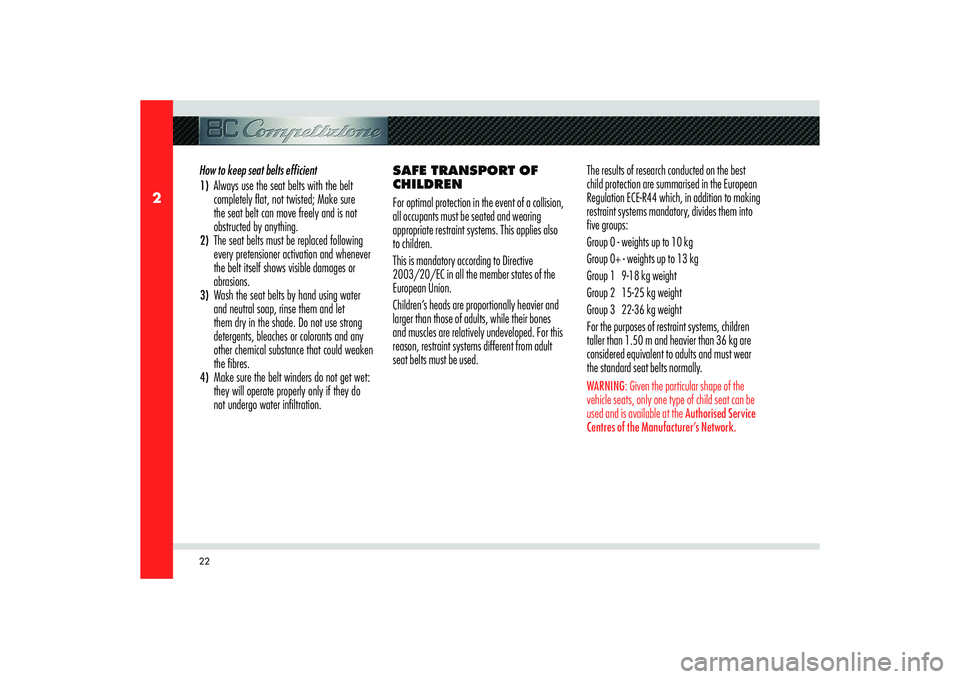
22
2
How to keep seat belts effi cient
1) Always use the seat belts with the belt
completely fl at, not twisted; Make sure
the seat belt can move freely and is not
obstructed by anything.
2) The seat belts must be replaced following
every pretensioner activation and whenever
the belt itself shows visible damages or
abrasions.
3) Wash the seat belts by hand using water
and neutral soap, rinse them and let
them dry in the shade. Do not use strong
detergents, bleaches or colorants and any
other chemical substance that could weaken
the fi bres.
4) Make sure the belt winders do not get wet:
they will operate properly only if they do
not undergo water infi ltration. SAFE TRANSPORT OF
CHILDREN
For optimal protection in the event of a collision,
all occupants must be seated and wearing
appropriate restraint systems. This applies also
to children.
This is mandatory according to Directive
2003/20/EC in all the member states of the
European Union.
Children’s heads are proportionally heavier and
larger than those of adults, while their bones
and muscles are relatively undeveloped. For this
reason, restraint systems different from adult
seat belts must be used.The results of research conducted on the best
child protection are summarised in the European
Regulation ECE-R44 which, in addition to making
restraint systems mandatory, divides them into
five groups:
Group 0 - weights up to 10 kg
Group 0+ - weights up to 13 kg
Group 1 9-18 kg weight
Group 2 15-25 kg weight
Group 3 22-36 kg weight
For the purposes of restraint systems, children
taller than 1.50 m and heavier than 36 kg are
considered equivalent to adults and must wear
the standard seat belts normally.
WARNING: Given the particular shape of the
vehicle seats, only one type of child seat can be
used and is available at the Authorised Service
Centres of the Manufacturer’s Network.
Page 26 of 223
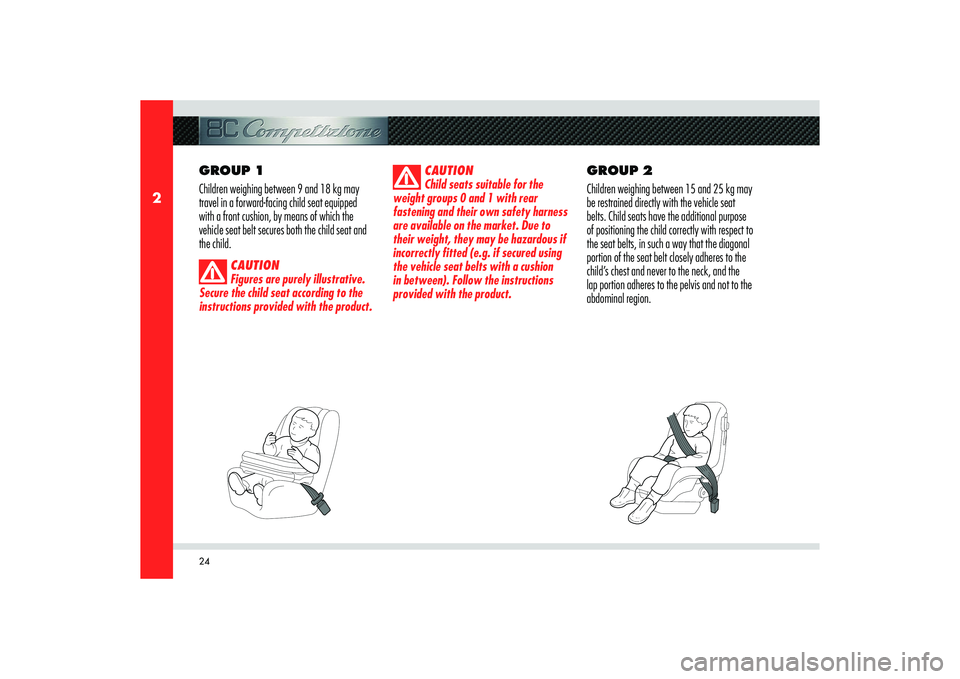
24
2
GROUP 1
Children weighing between 9 and 18 kg may
travel in a forward-facing child seat equipped
with a front cushion, by means of which the
vehicle seat belt secures both the child seat and
the child.
CAUTION
Figures are purely illustrative.
Secure the child seat according to the
instructions provided with the product.CAUTION
Child seats suitable for the
weight groups 0 and 1 with rear
fastening and their own safety harness
are available on the market. Due to
their weight, they may be hazardous if
incorrectly fitted (e.g. if secured using
the vehicle seat belts with a cushion
in between). Follow the instructions
provided with the product.
GROUP 2
Children weighing between 15 and 25 kg may
be restrained directly with the vehicle seat
belts. Child seats have the additional purpose
of positioning the child correctly with respect to
the seat belts, in such a way that the diagonal
portion of the seat belt closely adheres to the
child’s chest and never to the neck, and the
lap portion adheres to the pelvis and not to the
abdominal region.
Page 32 of 223
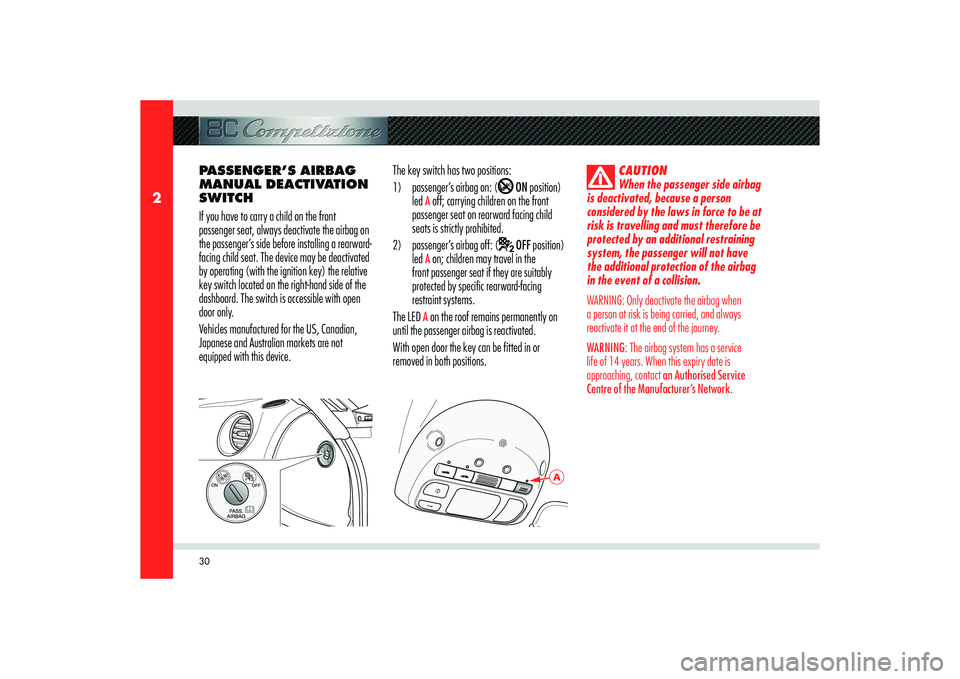
30
2
A
PASSENGER’S AIRBAG
MANUAL DEACTIVATION
SWITCH
If you have to carry a child on the front
passenger seat, always deactivate the airbag on
the passenger’s side before installing a rearward-
facing child seat. The device may be deactivated
by operating (with the ignition key) the relative
key switch located on the right-hand side of the
dashboard. The switch is accessible with open
door only.
Vehicles manufactured for the US, Canadian,
Japanese and Australian markets are not
equipped with this device.The key switch has two positions:
1) passenger’s airbag on: (
ON position)
led
A off; carrying children on the front
passenger seat on rearward facing child
seats is strictly prohibited.
2) passenger’s airbag off: (
OFF position)
led
A on; children may travel in the
front passenger seat if they are suitably
protected by specific rearward-facing
restraint systems.
The LED A on the roof remains permanently on
until the passenger airbag is reactivated.
With open door the key can be fitted in or
removed in both positions.
CAUTION
When the passenger side airbag
is deactivated, because a person
considered by the laws in force to be at
risk is travelling and must therefore be
protected by an additional restraining
system, the passenger will not have
the additional protection of the airbag
in the event of a collision.
WARNING: Only deactivate the airbag when
a person at risk is being carried, and always
reactivate it at the end of the journey.
WARNING: The airbag system has a service
life of 14 years. When this expiry date is
approaching, contact an Authorised Service
Centre of the Manufacturer’s Network.
Page 79 of 223
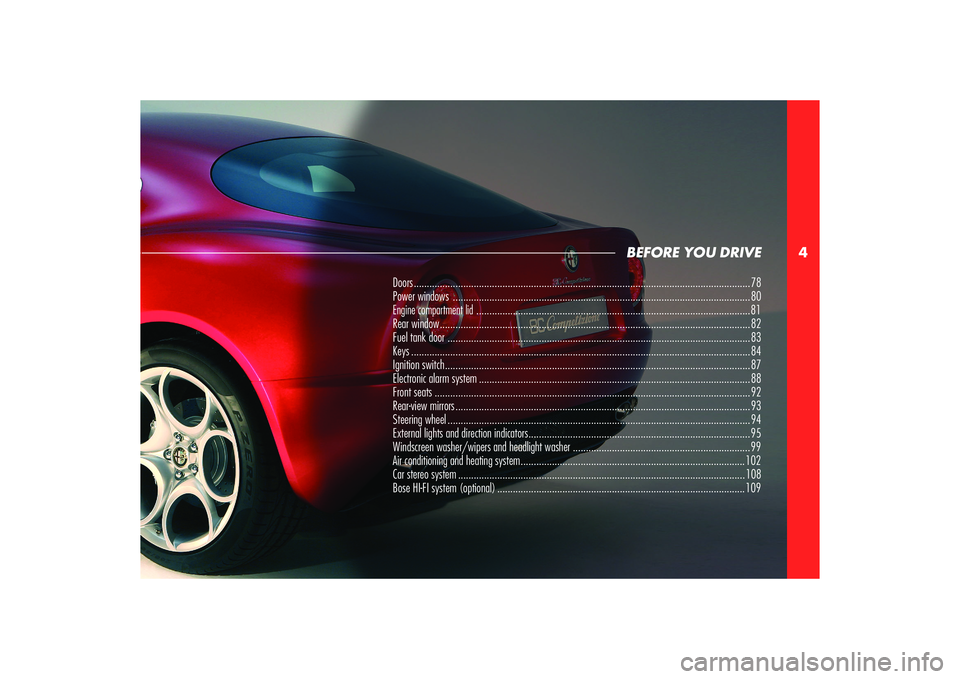
4
BEFORE YOU DRIVE
Doors ................................................................................................................................. 78
Power windows .................................................................................................................. 80Engine compartment lid
......................................................................................................... 81
Rear window ....................................................................................................................... 82
Fuel tank door .................................................................................................................... 83
Keys .................................................................................................................................. 84
Ignition switch ..................................................................................................................... 87
Electronic alarm system ........................................................................................................88
Front seats ......................................................................................................................... 92
Rear-view mirrors ................................................................................................................. 93
Steering wheel .................................................................................................................... 94
External lights and direction indicators ..................................................................................... 95
Windscreen washer/wipers and headlight washer .................................................................... 99
Air conditioning and heating system ...................................................................................... 102
Car stereo system .............................................................................................................. 108
Bose HI-FI system (optional) ............................................................................................... 109
Page 84 of 223
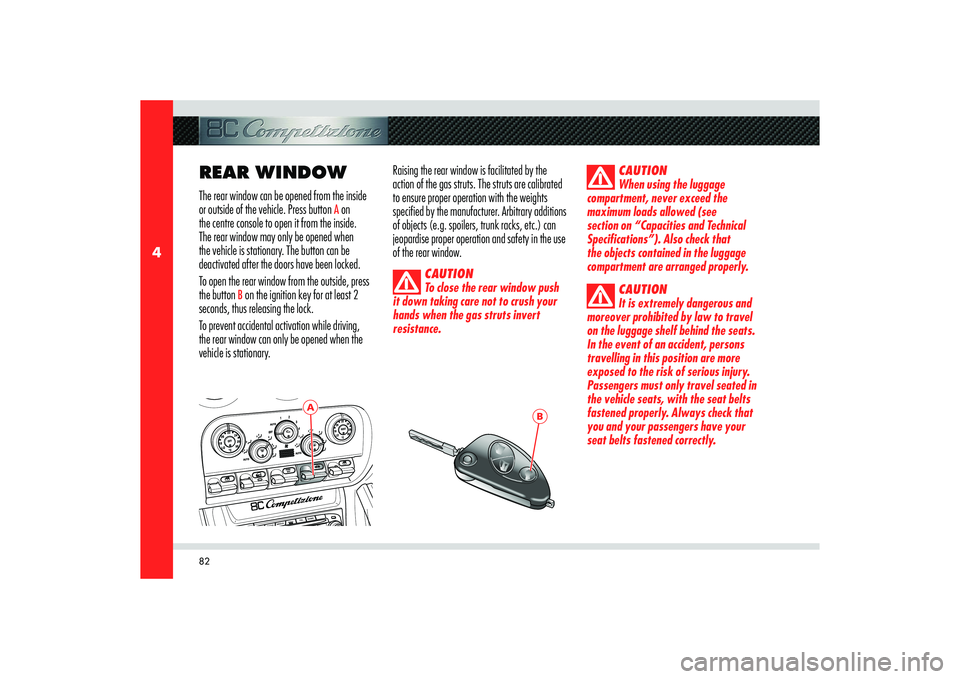
82
4
A
B
REAR WINDOWThe rear window can be opened from the inside
or outside of the vehicle. Press button
A on
the centre console to open it from the inside.
The rear window may only be opened when
the vehicle is stationary. The button can be
deactivated after the doors have been locked.
To open the rear window from the outside, press
the button
B on the ignition key for at least 2
seconds, thus releasing the lock.
To prevent accidental activation while driving,
the rear window can only be opened when the
vehicle is stationary.Raising the rear window is facilitated by the
action of the gas struts. The struts are calibrated
to ensure proper operation with the weights
specified by the manufacturer. Arbitrary additions
of objects (e.g. spoilers, trunk racks, etc.) can
jeopardise proper operation and safety in the use
of the rear window.
CAUTION
To close the rear window push
it down taking care not to crush your
hands when the gas struts invert
resistance.
CAUTION
When using the luggage
compartment, never exceed the
maximum loads allowed (see
section on “Capacities and Technical
Specifications”). Also check that
the objects contained in the luggage
compartment are arranged properly.
CAUTION
It is extremely dangerous and
moreover prohibited by law to travel
on the luggage shelf behind the seats.
In the event of an accident, persons
travelling in this position are more
exposed to the risk of serious injury.
Passengers must only travel seated in
the vehicle seats, with the seat belts
fastened properly. Always check that
you and your passengers have your
seat belts fastened correctly.
Page 85 of 223
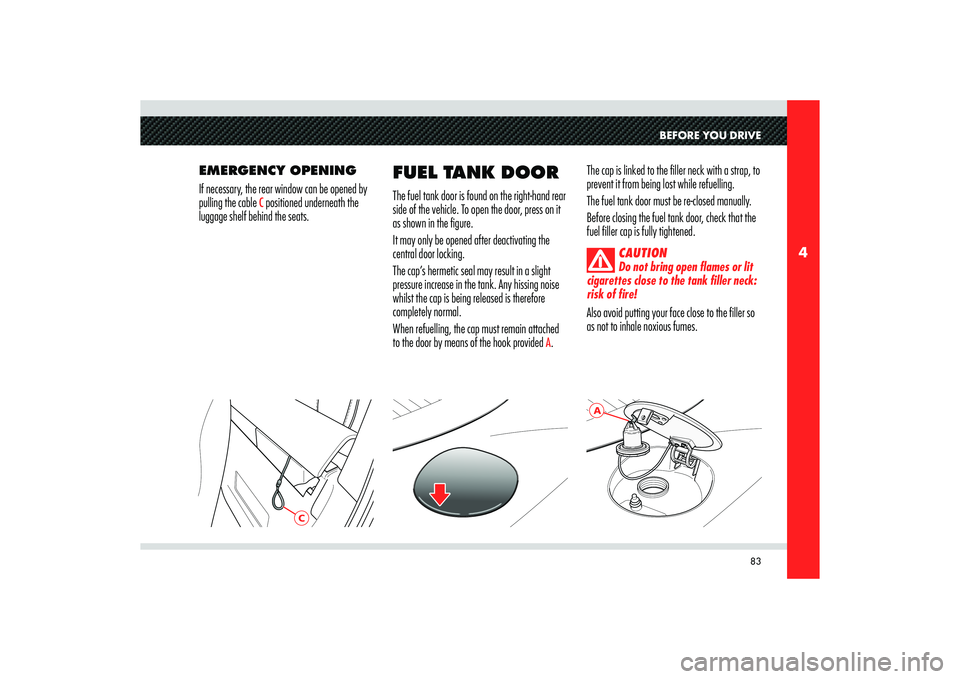
83
4
A
C
BEFORE YOU DRIVE
EMERGENCY OPENING
If necessary, the rear window can be opened by
pulling the cable
C positioned underneath the
luggage shelf behind the seats.The cap is linked to the filler neck with a strap, to
prevent it from being lost while refuelling.
The fuel tank door must be re-closed manually.
Before closing the fuel tank door, check that the
fuel filler cap is fully tightened.
CAUTION
Do not bring open flames or lit
cigarettes close to the tank filler neck:
risk of fire!
Also avoid putting your face close to the filler so
as not to inhale noxious fumes.
FUEL TANK DOOR The fuel tank door is found on the right-hand rear
side of the vehicle. To open the door, press on it
as shown in the figure.
It may only be opened after deactivating the
central door locking.
The cap’s hermetic seal may result in a slight
pressure increase in the tank. Any hissing noise
whilst the cap is being released is therefore
completely normal.
When refuelling, the cap must remain attached
to the door by means of the hook provided
A.
Page 94 of 223
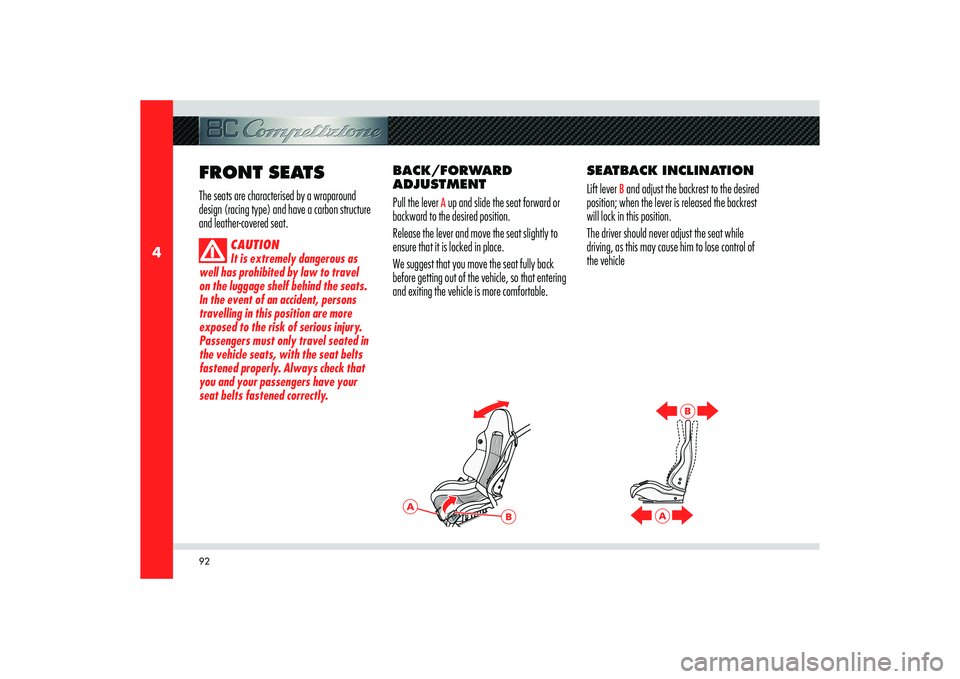
92
4
A
B
A
B
FRONT SEATSThe seats are characterised by a wraparound
design (racing type) and have a carbon structure
and leather-covered seat.
CAUTION
It is extremely dangerous as
well has prohibited by law to travel
on the luggage shelf behind the seats.
In the event of an accident, persons
travelling in this position are more
exposed to the risk of serious injury.
Passengers must only travel seated in
the vehicle seats, with the seat belts
fastened properly. Always check that
you and your passengers have your
seat belts fastened correctly.
BACK/FORWARD
ADJUSTMENT
Pull the lever
A up and slide the seat forward or
backward to the desired position.
Release the lever and move the seat slightly to
ensure that it is locked in place.
We suggest that you move the seat fully back
before getting out of the vehicle, so that entering
and exiting the vehicle is more comfortable. SEATBACK INCLINATION
Lift lever
B and adjust the backrest to the desired
position; when the lever is released the backrest
will lock in this position.
The driver should never adjust the seat while
driving, as this may cause him to lose control of
the vehicle
Page 132 of 223
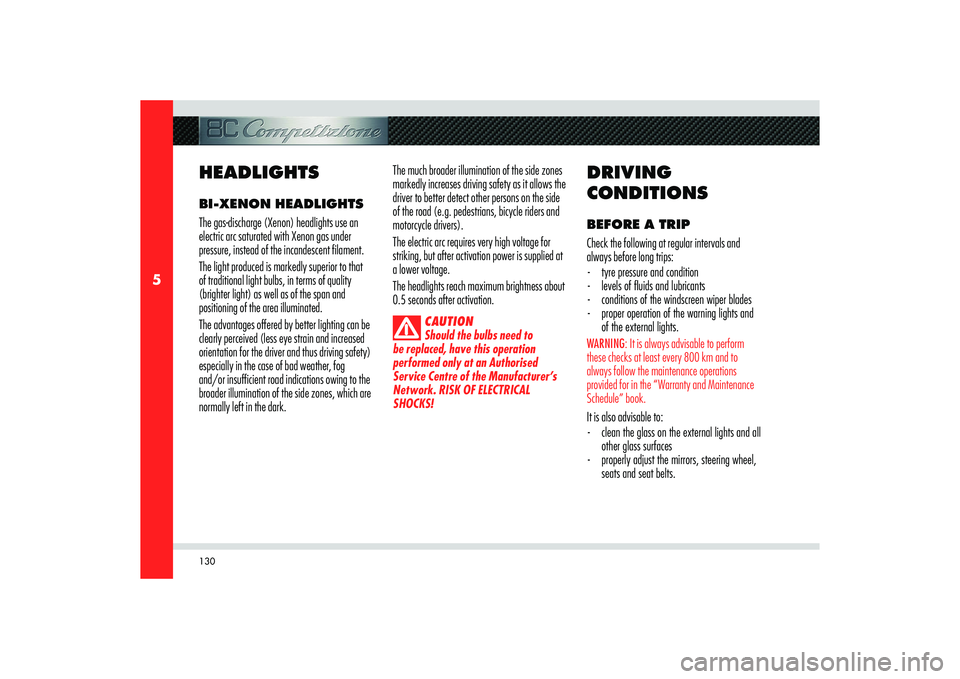
130
5
HEADLIGHTSBI-XENON HEADLIGHTS
The gas-discharge (Xenon) headlights use an
electric arc saturated with Xenon gas under
pressure, instead of the incandescent filament.
The light produced is markedly superior to that
of traditional light bulbs, in terms of quality
(brighter light) as well as of the span and
positioning of the area illuminated.
The advantages offered by better lighting can be
clearly perceived (less eye strain and increased
orientation for the driver and thus driving safety)
especially in the case of bad weather, fog
and/or insufficient road indications owing to the
broader illumination of the side zones, which are
normally left in the dark.The much broader illumination of the side zones
markedly increases driving safety as it allows the
driver to better detect other persons on the side
of the road (e.g. pedestrians, bicycle riders and
motorcycle drivers).
The electric arc requires very high voltage for
striking, but after activation power is supplied at
a lower voltage.
The headlights reach maximum brightness about
0.5 seconds after activation.
CAUTION
Should the bulbs need to
be replaced, have this operation
performed only at an Authorised
Service Centre of the Manufacturer’s
Network. RISK OF ELECTRICAL
SHOCKS!
DRIVING
CONDITIONSBEFORE A TRIP
Check the following at regular intervals and
always before long trips:
- tyre pressure and condition
- levels of fl uids and lubricants
- conditions of the windscreen wiper blades
- proper operation of the warning lights and
of the external lights.WARNING: It is always advisable to perform
these checks at least every 800 km and to
always follow the maintenance operations
provided for in the “Warranty and Maintenance
Schedule” book.It is also advisable to:
- clean the glass on the external lights and all
other glass surfaces
- properly adjust the mirrors, steering wheel,
seats and seat belts.
Page 133 of 223
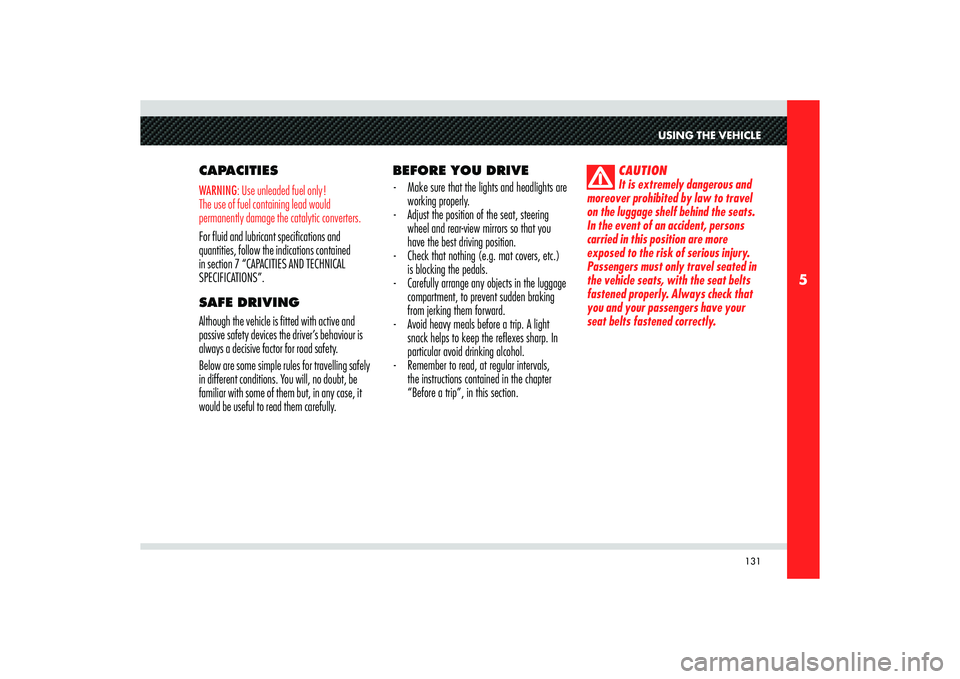
131
5
USING THE VEHICLE
CAPACITIESWARNING: Use unleaded fuel only!
The use of fuel containing lead would
permanently damage the catalytic converters.For fluid and lubricant specifications and
quantities, follow the indications contained
in section 7 “CAPACITIES AND TECHNICAL
SPECIFICATIONS”.
SAFE DRIVING
Although the vehicle is fitted with active and
passive safety devices the driver’s behaviour is
always a decisive factor for road safety.
Below are some simple rules for travelling safely
in different conditions. You will, no doubt, be
familiar with some of them but, in any case, it
would be useful to read them carefully.BEFORE YOU DRIVE
- Make sure that the lights and headlights are
working properly.
- Adjust the position of the seat, steering
wheel and rear-view mirrors so that you
have the best driving position.
- Check that nothing (e.g. mat covers, etc.)
is blocking the pedals.
- Carefully arrange any objects in the luggage
compartment, to prevent sudden braking
from jerking them forward.
- Avoid heavy meals before a trip. A light
snack helps to keep the refl exes sharp. In
particular avoid drinking alcohol.
- Remember to read, at regular intervals,
the instructions contained in the chapter
“Before a trip”, in this section.
CAUTION
It is extremely dangerous and
moreover prohibited by law to travel
on the luggage shelf behind the seats.
In the event of an accident, persons
carried in this position are more
exposed to the risk of serious injury.
Passengers must only travel seated in
the vehicle seats, with the seat belts
fastened properly. Always check that
you and your passengers have your
seat belts fastened correctly.